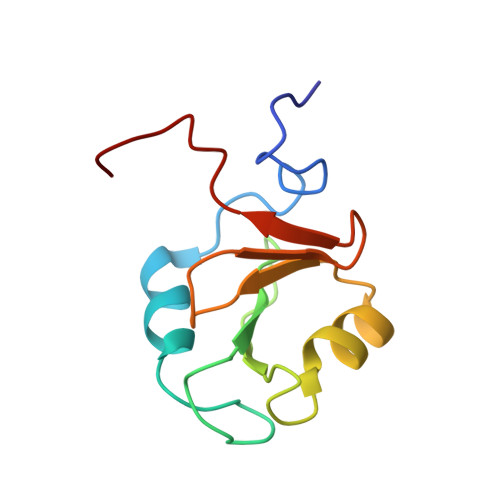Structural and functional studies of USP20 ZnF-UBP domain by NMR.
Yang, Y., Ding, Y., Zhou, C., Wen, Y., Zhang, N.(2019) Protein Sci 28: 1606-1619
- PubMed: 31278784
- DOI: https://doi.org/10.1002/pro.3675
- Primary Citation of Related Structures:
6KCZ - PubMed Abstract:
Deubiquitinase USP20/VDU2 has been demonstrated to play important roles in multiple cellular processes by controlling the life span of substrate proteins including hypoxia-inducible factor HIF1α, and so forth. USP20 contains four distinct structural domains including the N-terminal zinc-finger ubiquitin binding domain (ZnF-UBP), the catalytic domain (USP domain), and two tandem DUSP domains, and none of the structures for these four domains has been solved. Meanwhile, except for the ZnF-UBP domain, the biological functions for USP20's catalytic domain and tandem DUSP domains have been at least partially clarified. Here in this study, we determined the solution structure of USP20 ZnF-UBP domain and investigated its binding properties with mono-ubiquitin and poly-ubiquitin (K48-linked di-ubiquitin) by using NMR and molecular modeling techniques. USP20's ZnF-UBP domain forms a spherically shaped fold consisting of a central β-sheet with either one α-helix or two α-helices packed on each side of the sheet. However, although having formed a canonical core structure essential for ubiquitin recognition, USP20 ZnF-UBP presents weak ubiquitin binding capacity. The structural basis for understanding USP20 ZnF-UBP's ubiquitin binding capacity was revealed by NMR data-driven docking. Although the electrostatic interactions between D264 of USP5 (E87 in USP20 ZnF-UBP) and R74 of ubiquitin are kept, the loss of the extensive interactions formed between ubiquitin's di-glycine motif and the conserved and non-conserved residues of USP20 ZnF-UBP domain (W41, E55, and Y84) causes a significant decrease in its binding affinity to ubiquitin. Our findings indicate that USP20 ZnF-UBP domain might have a physiological role unrelated to its ubiquitin binding capacity.
- Department of Analytical Chemistry, Shanghai Institute of Materia Medica Chinese Academy of Sciences, Shanghai, China.
Organizational Affiliation:

















